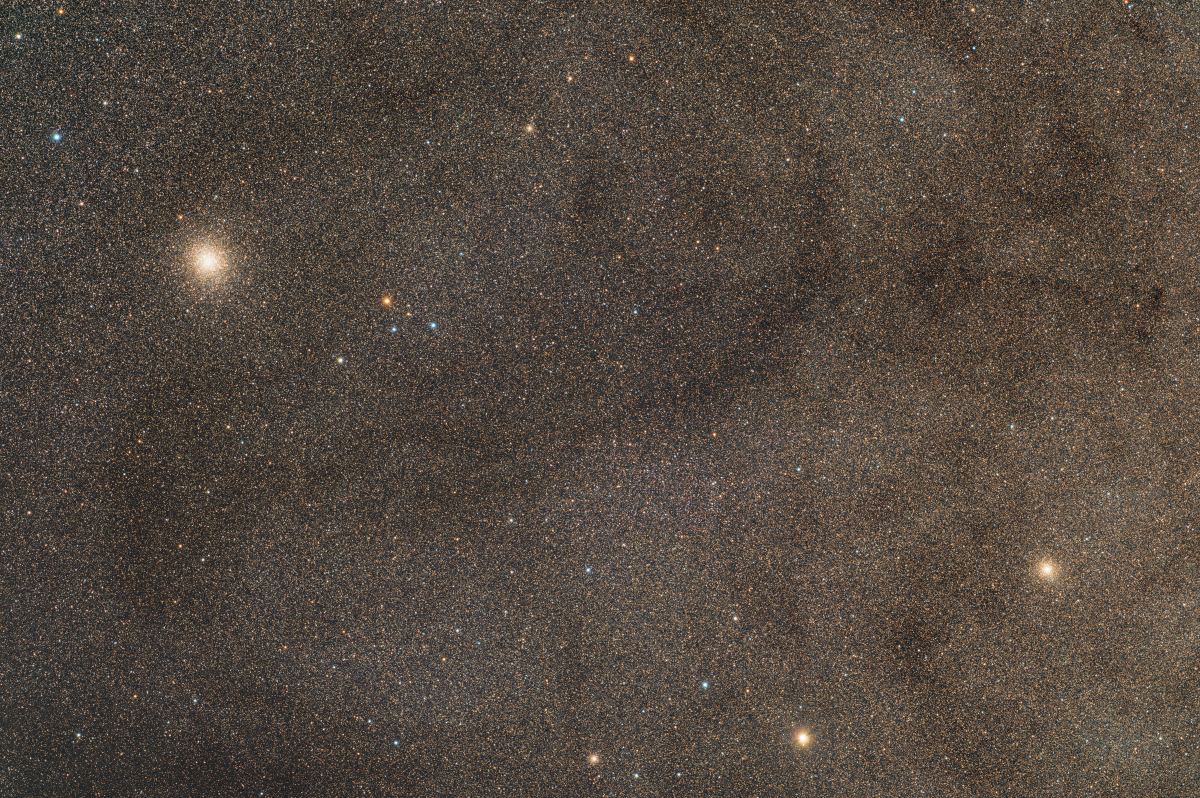
[back] M 22 and M28 in Sagittarius
Big, 100% image version / Große, 100% Bild-Version (9466 x 6295 pixel, 1.464"/pixel)

|
(c) 2023 All astro photo images are copyrighted. They may not be used or reproduced without explicit written permission from the authors. |
|
0.5 degree |
|
About this Image / Über dieses Bild
| Camera: | Moravian C3-PRO-61000 Mono CMOS |
| Image Type, Orientation: | RGB Color Composite, North is at 12:00 |
| Exposure time: | R,G,B: 40*120 sec. each (4:00h total) |
| Exposure date: | July 26th, 2023 |
| Location: | Capella Observatory South at Kiripotib Astro Farm, Namibia |
| Filter: | Astronomik Deep-Sky Deep-Sky RGB Filter set on Moravian EFW-3L-9-II External Filter Wheel |
| Instrument: | "Callisto", a Takahashi FSQ 106N, 530mm focal length, 106mm aperture, f/5 on modified Losmandy G11 (high res encoders with OnStepX) |
| Photographer: | Rainer Raupach, Josef Pöpsel, Frank Sackenheim |
| Remarks: |
Messier 22 (left) is the brightest globular cluster
observable from Central Europe with a magnitude of 5.1. It is located in the
constellation of Sagittarius and, when observed from there, it reaches only
low altitudes. However, in Namibia, it moves practically through the zenith.
Its distance is approximately 10,000 light-years. In 2012, it was discovered
that M 22 contains more than just one black hole, which was previously
considered unlikely due to the long-term stability of globular clusters1.
The two objects M22-VLA1 and M22-VLA2 each have masses equivalent to about
10-20 times that of the Sun. Messier 28 (right) is nearly twice as far away at a distance of 18,000 light-years and has only about half the absolute diameter of M 22. Both of these factors make it appear significantly smaller than M 22. Additionally, two more globular clusters are visible: NGC 6642 (above, slightly to the left) and NGC 6638 (bottom center), both even more distant at 23,000 and 31,000 light-years, respectively. There are also two small planetary nebulae visible: NGC 6629 (top right) and NGC 6644 (left above NGC 6638), both appearing bluish. However, they are so small that at this focal length, they are difficult to distinguish from stars. BlurrXTerminator was used for the image (option "correct only") |
|
|
|
| Bemerkungen: |
Messier 22 (links) ist mit 5.1
mag der hellste von Mitteleuropa aus beobachtbare Kugelsternhaufen. Er
befindet sich im Sternbild Schütze und erreicht deswegen von dort aus
betrachtet nur geringe Horizonthöhen, aber in Namibia bewegt er sich
praktisch durch den Zenit. Seine Entfernung beträgt ca. 10.000 Lichtjahre.
Seit 2012 weiß man, dass M 22 mehr als nur ein schwarzes Loch beherbergt,
was aus Gründen der langfristigen Stabilität des Kugelsternhaufens als
ausgeschlossen galt1. Die beiden Objekte M22-VLA1 und M22-VLA2 haben jeweils
etwa 10-20 Sonnenmassen. |
Back to the Globular Clusters Overview / Zurück zur Kugelsternhaufen-Übersichtsseite